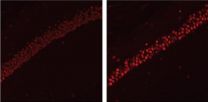Snow leopard diet determined by DNA analysis of fecal samples
2012-03-01
(Press-News.org) Knowledge about animal diet can inform conservation strategy, but this information can be difficult to gather. A new DNA-based method, which analyzes genetic material from feces, could be a useful tool, and researchers have shown its utility to characterize the diet of snow leopards in Mongolia.
The full results are reported Feb. 29 in the open access journal PLoS ONE.
Analysis of DNA from 81 fecal samples showed that the leopards ate mostly Siberian ibex, followed by domestic goats and wild sheep. Most of the animals eaten were wild (79 %), with a relatively low proportion of domestic livestock (19.7 %). The authors, led by Pierre Taberlet of Centre National de la Recherche Scientifique in France, write that the results help further the understanding of snow leopard feeding, which can help address related conservation and management issues.
INFORMATION:
Citation: Shehzad W, McCarthy TM, Pompanon F, Purevjav L, Coissac E, et al. (2012) Prey Preference of Snow Leopard (Panthera uncia) in South Gobi, Mongolia. PLoS ONE 7(2): e32104. doi:10.1371/journal.pone.0032104
Contact: Dr. Pierre Taberlet (pierre.taberlet@ujf-grenoble.fr) +33 476 63 54 33 (France), Mobile: +33 680 85 69 26 (France), or Thomas Michael McCarthy (tmccarthy@panthera.org) 206-384-2147 (US)
Financial Disclosure: This work was funded by Laboratoire d'Ecologie Alpine, UMR 5553, Centre National de la Recherche Scientifique, France. Partial funding was provided by Snow Leopard Conservation Grant Program for 2010. The funders had no role in study design, data collection and analysis, decision to publish, or preparation of this manuscript.
Competing Interest: EC, TR and PT are co-inventors of a pending French patent application entitled ''Amorces universelles et leurutilisation pour la de´tection et l'identification d'espe`ces deverte´bre´ s'' which has been submitted in France on 26 May 2011. Reference number: FR 11/54606, on the primer pair named 12SV5F and 12SV5R and on the use of the amplified fragment for identifying vertebrate species from environmental samples. This patent only restricts commercial applications and has no impact on the use of this method by academic researchers. This does not alter the authors' adherence to all the PLoS ONE policies on sharing data and materials.
Disclaimer: This press release refers to upcoming articles in PLoS ONE. The releases have been provided by the article authors and/or journal staff. Any opinions expressed in these are the personal views of the contributors, and do not necessarily represent the views or policies of PLoS. PLoS expressly disclaims any and all warranties and liability in connection with the information found in the release and article and your use of such information.
About PLoS ONE
PLoS ONE is the first journal of primary research from all areas of science to employ a combination of peer review and post-publication rating and commenting, to maximize the impact of every report it publishes. PLoS ONE is published by the Public Library of Science (PLoS), the open-access publisher whose goal is to make the world's scientific and medical literature a public resource.
All works published in PLoS ONE are Open Access. Everything is immediately available—to read, download, redistribute, include in databases and otherwise use—without cost to anyone, anywhere, subject only to the condition that the original authors and source are properly attributed. For more information about PLoS ONE relevant to journalists, bloggers and press officers, including details of our press release process and our embargo policy, see the everyONE blog at http://everyone.plos.org/media.
END
ELSE PRESS RELEASES FROM THIS DATE:
2012-03-01
Millions of years after its extinction, Triceratops is inciting controversy about how to classify the ancient animals. New analysis, published Feb. 29 in the open access journal PLoS ONE, suggests that the specimens in question should be classified into two separate groups, Triceratops and Torosaurus, and are not individuals of different ages from the same genus, as others have proposed.
The researchers, led by Nicholas Longrich of Yale University, performed detailed morphological and computational analysis of 35 specimens and found evidence that Triceratops and Torosaurus ...
2012-03-01
"We used a trick called earthshine observation to look at the Earth as if it were an exoplanet," says Michael Sterzik (ESO), lead author of the paper [1]. "The Sun shines on the Earth and this light is reflected back to the surface of the Moon. The lunar surface acts as a giant mirror and reflects the Earth's light back to us — and this is what we have observed with the VLT."
The astronomers analyse the faint earthshine light to look for indicators, such as certain combinations of gases in the Earth's atmosphere [2], that are the telltale signs of organic life. This method ...
2012-03-01
A repression of gene activity in the brain appears to be an early event affecting people with Alzheimer's disease, researchers funded by the National Institutes of Health have found. In mouse models of Alzheimer's disease, this epigenetic blockade and its effects on memory were treatable.
"These findings provide a glimpse of the brain shutting down the ability to form new memories gene by gene in Alzheimer's disease, and offer hope that we may be able to counteract this process," said Roderick Corriveau, Ph.D., a program director at NIH's National Institute of Neurological ...
2012-03-01
Some women considering breast augmentation worry that, after having this procedure, styles will change and they will, of a sudden, be out of fashion. It is important to remember that fashions do change. Every year there are new clothing options, often in flattering shapes and colors. What is more likely is that smaller, undefined breasts actually inhibit you form wearing the latest fashions and may completely eliminate many clothing options.
Style and fashion are not the same thing. Breast augmentation isn't about fashion, it's about style; your style to be specific. ...
2012-03-01
In a mouse model of Alzheimer's disease, memory problems stem from an overactive enzyme that shuts off genes related to neuron communication, a new study says.
When researchers genetically blocked the enzyme, called HDAC2, they 'reawakened' some of the neurons and restored the animals' cognitive function. The results, published February 29, 2012, in the journal Nature, suggest that drugs that inhibit this particular enzyme would make good treatments for some of the most devastating effects of the incurable neurodegenerative disease.
"It's going to be very important ...
2012-03-01
One year on from the magnitude-9.0 earthquake that unleashed a devastating tsunami and caused a partial meltdown of the Fukushima Daiichi nuclear plant, this month's special issue of Physics World, on the theme of "Physics and the Earth", includes an investigation by journalist Edwin Cartlidge into the latest advances in earthquake forecasting.
In addition to the special issue, physicsworld.com hosts an exclusive video documentary reviewing the fundamental science behind earthquakes and assessing the current efforts that are being made around the world to forecast these ...
2012-03-01
Victims of truck accidents often find themselves mired in a frustrating and complex legal process when trying to seek compensation.
Part of this has to do with the number of parties that may be held accountable in a truck accident. The driver, the trucking company, the personnel who loaded the trailer, and even truck part manufacturers can be held responsible for damages in a truck accident depending on the circumstances.
When you hire a truck accident attorney, one of the first things he or she will look for is potential violations of federal trucking laws. The Federal ...
2012-03-01
Urgent action is needed to reduce the high concentrations of dangerous air pollutants in Europe, according to experts writing in the European Respiratory Journal today (1 March 2012).
The European Respiratory Society's Environment and Health Committee are urging policymakers in Europe to introduce changes that will ensure the air that we breathe is safe and clean.
The call to action comes ahead of the upcoming review of air quality legislation in the European Union (EU) before the 2013 Year of Air. In the editorial, the ERS committee argues that any new legislation ...
2012-03-01
BOSTON, MA—Very recently, researchers discovered an important population of immune cells called memory T cells living in parts of the body that are in contact with the environment (e.g., skin, lung, GI tract). How these "resident" memory T cells are generated was unknown, and their importance with regard to how our immune system remembers infection and how it prevents against re-infection is being studied intensively.
Now, a study by a Brigham and Women's Hospital (BWH) research team led by Xiaodong Jiang, PhD, research scientist and Thomas S. Kupper, MD, Chair of ...
2012-03-01
(Cambridge, Mass.) -- More than 60 years ago, scientists discovered the underlying cause of sickle cell disease: People with the disorder produce crescent-shaped red blood cells that clog capillaries instead of flowing smoothly, like ordinary, disc-shaped red blood cells do. This can cause severe pain, major organ damage and a significantly shortened lifespan.
Researchers later found that the disease results from a single mutation in the hemoglobin protein, and realized that the sickle shape — seen more often in people from tropical climates — is actually an evolutionary ...
LAST 30 PRESS RELEASES:
[Press-News.org] Snow leopard diet determined by DNA analysis of fecal samples

